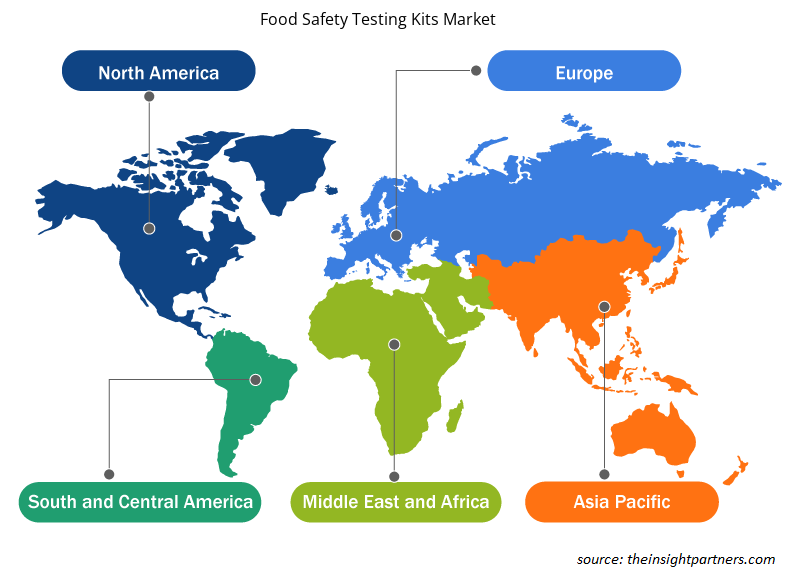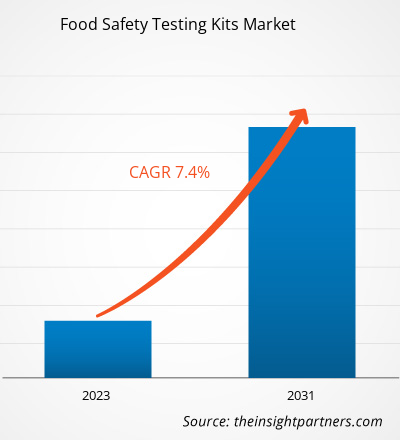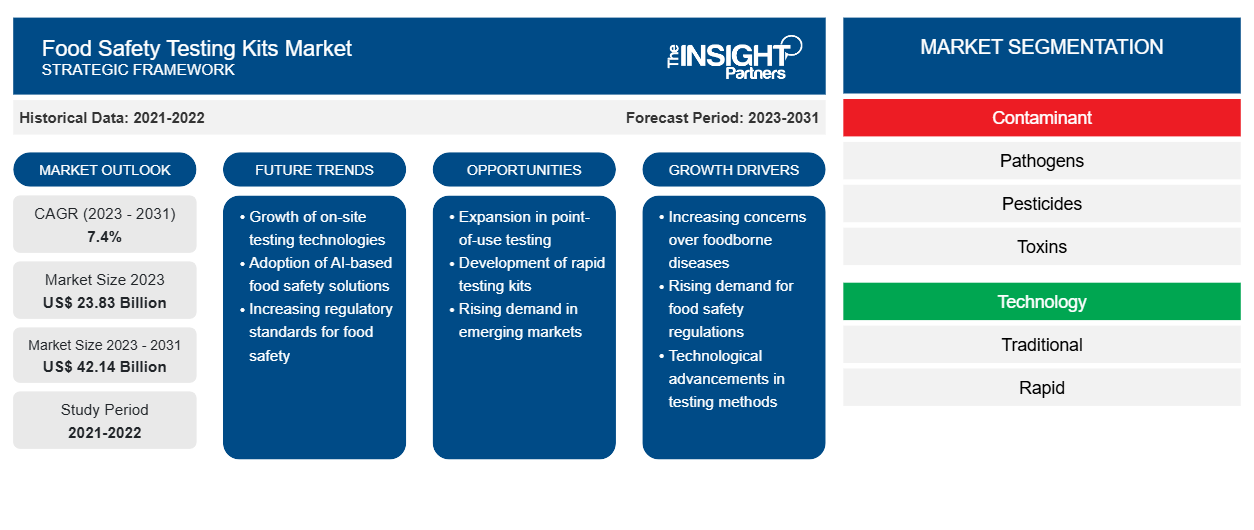Si prevede che la dimensione del mercato dei kit per test sulla sicurezza alimentare raggiungerà i 42,14 miliardi di dollari entro il 2031, rispetto ai 23,83 miliardi di dollari del 2023. Si prevede che il mercato registrerà un CAGR del 7,4% nel 2023-2031. È probabile che la significativa crescita del settore alimentare e delle bevande rimanga una delle principali tendenze del mercato dei kit per test sulla sicurezza alimentare.CAGR of 7.4% in 2023–2031. Significantly growing food & beverages industry is likely to remain key food safety testing kits market trends.
Analisi di mercato dei kit per test di sicurezza alimentare
Tutti gli antibiotici e gli altri antimicrobici vengono utilizzati per trattare le infezioni causate da batteri. L'uso improprio e l'uso eccessivo di antimicrobici nella medicina umana e veterinaria sono stati collegati all'emergere di batteri resistenti che rendono inefficace il trattamento di esseri umani e animali. La medicina antimicrobica è identificata come una delle più grandi minacce alla medicina moderna. Pertanto, è diventato estremamente importante rilevare in anticipo i contaminanti e impedire loro di entrare nella catena alimentare. Pertanto, l'importanza dei kit di test per la sicurezza alimentare è aumentata a livello globale in termini di volume. Inoltre, il calo della domanda di semi oleosi e cereali nel settore della ristorazione ha danneggiato le vendite nel 2020, si prevede che la riapertura delle piattaforme di ristorazione globali e i prezzi di vendita più elevati aumenteranno la crescita del mercato dei kit di test per la sicurezza alimentare nel periodo di previsione.
Panoramica del mercato dei kit per test di sicurezza alimentare
Il test di sicurezza alimentare è un'analisi scientifica di un prodotto alimentare e del suo contenuto per trovare informazioni su varie caratteristiche come proprietà fisico-chimiche, composizione e struttura. Le informazioni vengono utilizzate per determinare la sicurezza del prodotto per il consumo. La crescente prevalenza di malattie trasmesse dagli alimenti richiede test di sicurezza alimentare per tutti i prodotti alimentari e delle bevande per prevenire rischi per la salute, il che aumenta la crescita del mercato dei kit di test di sicurezza alimentare.
Personalizza questo report in base alle tue esigenze
Riceverai la personalizzazione gratuita di qualsiasi report, comprese parti di questo report, o analisi a livello nazionale, pacchetto dati Excel, oltre a usufruire di grandi offerte e sconti per start-up e università
-
Scopri le principali tendenze di mercato in questo rapporto.Questo campione GRATUITO includerà analisi di dati che spaziano dalle tendenze di mercato alle stime e alle previsioni.
Kit per test sulla sicurezza alimentare: fattori trainanti e opportunità di mercato
L'ascesa dell'industria alimentare e delle bevande a livello mondiale favorisce il mercato
L'industria alimentare e delle bevande comprende tutte le aziende coinvolte nella distribuzione, nel confezionamento e nella lavorazione di materiali alimentari. Ciò include bevande analcoliche, bevande alcoliche, alimenti confezionati e alimenti freschi. Quasi tutti i prodotti destinati al consumo umano, esclusi i prodotti farmaceutici, sono inclusi in questo settore. L' industria alimentare e delle bevande si sta concentrando sempre di più sulla manipolazione meccanica e sulla tecnologia per creare prodotti a più valore aggiunto. Inoltre, con la crescita della popolazione e l'aumento della classe media nei paesi in via di sviluppo, la domanda di varietà di prodotti alimentari è in aumento. Pertanto, con la crescita dell'industria alimentare e delle bevande che guida la crescita del mercato dei kit per i test sulla sicurezza alimentare.
Aumento del consumo di latte: un’opportunità nel mercato dei kit per i test di sicurezza alimentare
Il settore lattiero-caseario è uno dei settori più vulnerabili alle malattie trasmesse dagli alimenti, poiché i prodotti lattiero-caseari ospitano una varietà di microrganismi. Poiché la pastorizzazione potrebbe non distruggere tutti i patogeni nel latte, i test sul latte diventano essenziali per garantirne la sicurezza. Il latte è anche uno dei prodotti che viene consumato quotidianamente in grandi quantità in tutto il mondo. Pertanto, l'elevato consumo di latte porta a un volume maggiore di kit per i test sulla sicurezza alimentare, spingendo ulteriormente il mercato.foodborne illnesses as dairy products harbor a variety of microorganisms. As pasteurization may not destroy all pathogens in milk, testing of milk becomes essential to ensure safety. Milk is also one of the products that is consumed daily in large quantities all over the world. Thus, the high milk consumption leads to a higher volume of food safety testing kits driving the market further.
Analisi della segmentazione del rapporto di mercato sui kit per test sulla sicurezza alimentare
I segmenti chiave che hanno contribuito alla derivazione dell'analisi di mercato dei kit per i test sulla sicurezza alimentare sono contaminanti, tecnologia e tipologia di alimento.
- In base ai contaminanti, il mercato dei kit per i test sulla sicurezza alimentare è suddiviso in patogeni, pesticidi, tossine, OGM e altri. Il segmento dei patogeni è ulteriormente suddiviso in Salmonella, E. coli, Listeria, Campylobacter, S. aureus e altri. Il segmento dei patogeni ha detenuto una quota di mercato maggiore nel 2023.
- In base alla tecnologia, il mercato è diviso in tradizionale e rapido. Il segmento rapido è categorizzato in test basati su PCR, test basati su immunoassay, LAMP e altri.
- In termini di applicazione, il mercato è segmentato in prodotti a base di carne, pollame e frutti di mare; prodotti lattiero-caseari; cereali e granaglie; alimenti trasformati; frutta e verdura; e altri. Il segmento dei prodotti a base di carne, pollame e frutti di mare ha dominato il mercato nel 2023.
Analisi della quota di mercato dei kit per test di sicurezza alimentare per area geografica
L'ambito geografico del rapporto di mercato sui kit per i test sulla sicurezza alimentare è suddiviso principalmente in cinque regioni: Nord America, Asia Pacifico, Europa, Medio Oriente e Africa e Sud America/Sud e Centro America.
Il mercato dei kit per i test sulla sicurezza alimentare in Nord America è significativamente In Nord America, il mercato dei kit per i test sulla sicurezza alimentare è attualmente in fase di crescita e sta vivendo una crescita esponenziale. Il Nord America è un importante hub per la lavorazione alimentare. Secondo la Food and Drug Administration (FDA) degli Stati Uniti, a settembre 2022 erano registrate 99.451 strutture alimentari nazionali negli Stati Uniti. I paesi del Nord America hanno severi enti normativi in materia di sicurezza alimentare, si prevede che l'elevata quantità di lavorazione alimentare nella regione influirà positivamente sulla crescita del mercato dei kit per i test sulla sicurezza alimentare.
Approfondimenti regionali sul mercato dei kit per test sulla sicurezza alimentare
Le tendenze regionali e i fattori che influenzano il mercato dei kit per test di sicurezza alimentare durante il periodo di previsione sono stati ampiamente spiegati dagli analisti di Insight Partners. Questa sezione discute anche i segmenti e la geografia del mercato dei kit per test di sicurezza alimentare in Nord America, Europa, Asia Pacifico, Medio Oriente e Africa e Sud e Centro America.

- Ottieni i dati specifici regionali per il mercato dei kit di test per la sicurezza alimentare
Ambito del rapporto di mercato sui kit per test sulla sicurezza alimentare
| Attributo del report | Dettagli |
|---|---|
| Dimensioni del mercato nel 2023 | 23,83 miliardi di dollari USA |
| Dimensioni del mercato entro il 2031 | 42,14 miliardi di dollari USA |
| CAGR globale (2023-2031) | 7,4% |
| Dati storici | 2021-2022 |
| Periodo di previsione | 2023-2031 |
| Segmenti coperti |
Per contaminante
|
| Regioni e Paesi coperti |
America del Nord
|
| Leader di mercato e profili aziendali chiave |
|
Densità degli attori del mercato dei kit per test sulla sicurezza alimentare: comprendere il suo impatto sulle dinamiche aziendali
Il mercato dei kit per test sulla sicurezza alimentare sta crescendo rapidamente, spinto dalla crescente domanda degli utenti finali dovuta a fattori quali l'evoluzione delle preferenze dei consumatori, i progressi tecnologici e una maggiore consapevolezza dei benefici del prodotto. Con l'aumento della domanda, le aziende stanno ampliando le loro offerte, innovando per soddisfare le esigenze dei consumatori e capitalizzando sulle tendenze emergenti, il che alimenta ulteriormente la crescita del mercato.
La densità degli operatori di mercato si riferisce alla distribuzione di aziende o società che operano in un particolare mercato o settore. Indica quanti concorrenti (operatori di mercato) sono presenti in un dato spazio di mercato in relazione alle sue dimensioni o al valore di mercato totale.
Le principali aziende che operano nel mercato dei kit per i test sulla sicurezza alimentare sono:
- SGS SA
- Eurofins Scientific
- Gruppo Intertek Plc
- TÜV SUD
- Azienda: AES Laboratories Pvt. Ltd.
Disclaimer : le aziende elencate sopra non sono classificate secondo un ordine particolare.

- Ottieni la panoramica dei principali attori del mercato dei kit per test sulla sicurezza alimentare
Kit per test di sicurezza alimentare: novità di mercato e sviluppi recenti
Il mercato dei kit per test sulla sicurezza alimentare viene valutato raccogliendo dati qualitativi e quantitativi dopo la ricerca primaria e secondaria, che include importanti pubblicazioni aziendali, dati associativi e database. Di seguito è riportato un elenco degli sviluppi nel mercato per innovazioni, espansione aziendale e strategie:
- A maggio 2021, Eurofins Food and Water Testing UK & Ireland ha annunciato l'acquisizione di Alliance Technical Laboratories (ATL) Ltd. L'acquisizione migliorerà la fornitura di servizi di analisi di alimenti, acqua e mangimi dell'azienda nel sud-est e fa parte del suo programma di crescita strategica pianificato. (Fonte: Eurofins, comunicato stampa)
- A giugno 2021, SGS ha annunciato l'apertura del suo nuovo laboratorio di analisi alimentare in Papua Nuova Guinea. Il nuovo laboratorio offre test di qualità riconosciuti a livello internazionale per i segmenti di mercato della produzione alimentare, dell'ospitalità e della vendita al dettaglio. La struttura offre un'ampia gamma di servizi di analisi, come indicatori di microbiologia alimentare, patogeni di microbiologia alimentare, microbiologia dell'acqua e chimica dell'acqua. (Fonte: SGS, Newsletter)
Copertura e risultati del rapporto di mercato sui kit per test sulla sicurezza alimentare
Il rapporto "Dimensioni e previsioni del mercato dei kit per test sulla sicurezza alimentare (2021-2031)" fornisce un'analisi dettagliata del mercato che copre le seguenti aree:
- Dimensioni e previsioni del mercato a livello globale, regionale e nazionale per tutti i segmenti di mercato chiave coperti dall'ambito
- Dinamiche di mercato come fattori trainanti, vincoli e opportunità chiave
- Principali tendenze future
- Analisi dettagliata delle cinque forze PEST/Porter e SWOT
- Analisi di mercato globale e regionale che copre le principali tendenze di mercato, i principali attori, le normative e gli sviluppi recenti del mercato
- Analisi del panorama industriale e della concorrenza che copre la concentrazione del mercato, l'analisi della mappa di calore, i principali attori e gli sviluppi recenti
- Profili aziendali dettagliati
- Analisi storica (2 anni), anno base, previsione (7 anni) con CAGR
- Analisi PEST e SWOT
- Valore/volume delle dimensioni del mercato - Globale, Regionale, Nazionale
- Industria e panorama competitivo
- Set di dati Excel
Report recenti
Rapporti correlati
Testimonianze
Motivo dell'acquisto
- Processo decisionale informato
- Comprensione delle dinamiche di mercato
- Analisi competitiva
- Analisi dei clienti
- Previsioni di mercato
- Mitigazione del rischio
- Pianificazione strategica
- Giustificazione degli investimenti
- Identificazione dei mercati emergenti
- Miglioramento delle strategie di marketing
- Aumento dell'efficienza operativa
- Allineamento alle tendenze normative























 Ottieni un campione gratuito per - Mercato dei kit per test sulla sicurezza alimentare
Ottieni un campione gratuito per - Mercato dei kit per test sulla sicurezza alimentare